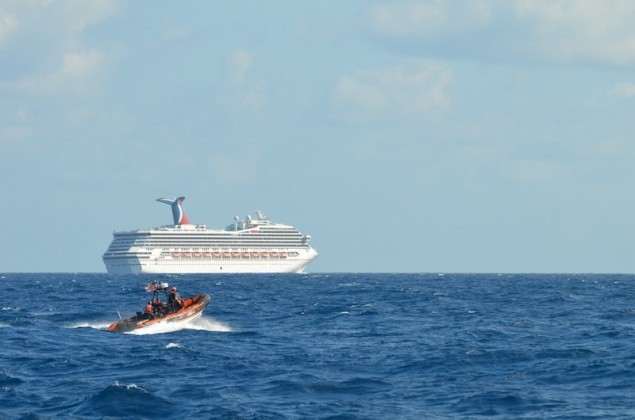A Coast Guard boat patrols near the cruise ship Carnival Triumph in the Gulf of Mexico, Feb. 11, 2013. U.S. Coast Guard photo
 By Jane Sutton
By Jane Sutton
MIAMI BEACH, Fla., March 12 (Reuters) – Carnival Corp has launched a comprehensive review of its entire fleet after a fire crippled one of its ships last month, and will share its findings across the industry, Carnival Cruise Lines’ chief executive told a conference on Tuesday.
The engine-room fire disabled the Bahamian-flagged Carnival Triumph in the Gulf of Mexico, leaving it adrift with more than 4,000 passengers and crew aboard. The accident made headlines around the world and comedians had a field day with the ensuing plumbing problems.
Related: Carnival Triumph Incident Photos
“We’ve started a comprehensive review of our entire fleet,” Carnival Cruise Lines President and Chief Executive Gerry Cahill told the annual Cruise Shipping Miami conference.
“It will take us a little bit of time to complete it but you can rest assured that it is our highest priority in the entire organization, it is the thing we are most focused on and we will come up with some solutions that we can implement across our fleet,” he said.
The company has assembled teams of fire safety experts, naval architects, electrical and mechanical engineers and engine manufacturers to conduct its own investigation, Cahill added.
The Triumph was on its way back to Galveston, Texas, when a leak in a fuel return line caused a fire in the aft engine room. The ship has two independent engine rooms but the fire damage knocked out both, Cahill said.
A diesel generator kicked in to run emergency services, but could not run what Cahill described as “hotel services”, most notably the plumbing in the cabins.
Cahill said the company investigation would focus on fire prevention and suppression, engine-room backup systems, and on figuring out what hotel service facilities could be run with emergency generators.
Carnival is cooperating with ongoing investigations by the U.S. Coast Guard and National Transportation Safety Board and the Bahamian government, as well as a review by the Cruise Line International Association (CLIA), he added.
Carnival Corp is the world’s largest cruise line, with 100 ships under brands that include Carnival, Cunard, Holland America, Princess, Seabourn and Costa.
RIPPLE EFFECT
Cruise executives frequently say the attention lavished on their competitors’ new ships creates a rising tide of demand that benefits them all. Accidents cause similar ripples throughout the industry.
“The recent Triumph incident affects all of us,” said Christine Duffy, president and chief executive of CLIA, which represents 58 cruise lines worldwide. “Even though such incidents are rare, we don’t underestimate their impact.”
Nonetheless, industry projections are chronically rosy. Cruising is a $36 billion industry worldwide, part of a $9.9 trillion global travel industry that represents 9 percent of global GDP, according to the World Travel and Tourism Council.
Some 20 million people took cruises last year and CLIA projects this year’s total will rise 3.3 percent to hit 20.9 million.
“We have been the fastest-growing segment inside the travel industry,” Duffy said.
Despite tough economic times, passenger numbers have risen every year over the last decade, she said. North America is still far and away the biggest source of cruise passengers, though the percentage from outside North America rose to 31 percent last year, from 9 percent in 2000.
Industry officials expect strong growth in China and other parts of Asia, where tens of millions, if not hundreds of millions, of people are moving into the middle classes and eager to see the world.
“They may not be comfortable going on their own but are comfortable going on one of our ships,” Duffy said.
The industry has added 168 new ships since 2000. Twenty-five more oceangoing and river-cruising ships will come on line in the next two years, but the pace is slowing, ending a glut of berths that had led to discounting.
Kevin Sheehan, chief executive of Norwegian Cruise Line , which recently went public, predicted the industry would soon “move pricing to more respectable levels”.
If the economy holds steady or improves slightly “then this industry will outperform”, Sheehan said.
The cruise line chiefs say their industry is resilient, in part because it has good overall safety.
Sheehan called it “the safest, safest, safest vacation experience that anybody could ever have”.
Pierfrancesco Vago, chief executive of MSC Cruises, a privately owned European line, suggested vacationers have short memories. Last year’s Costa Concordia accident caused bookings in Italy to plummet, especially scaring away first-time cruisers, he said.
Bookings are still erratic, but are growing again, in part because cruising is perceived as good value, he said.
“It’s amazing how this 2012 has been forgotten. We’ve seen already the new wave season, 2013, that the first-comers are coming back again,” Vago said. “2013 is looking much better, stronger.”
(c) 2013 Thomson Reuters, Click For Restrictions

 Join The Club
Join The Club











